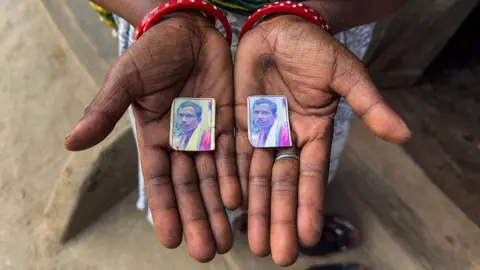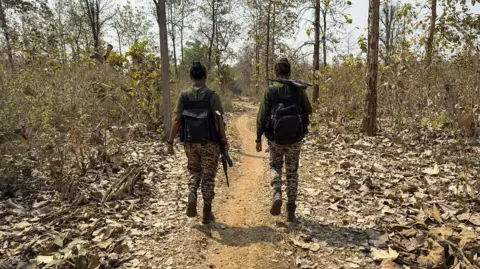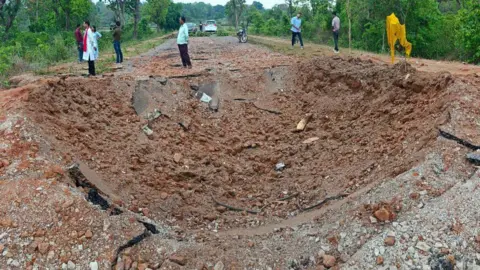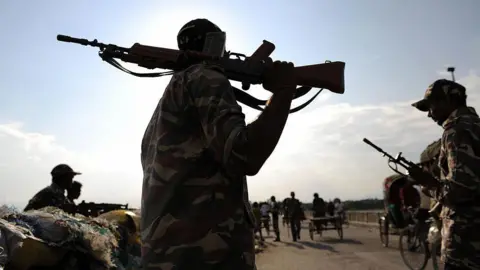Is India lastly successful the decades-long warfare towards Maoist insurgency?
 AFP through Getty Photographs
AFP through Getty PhotographsMight India’s decades-long jungle insurgency lastly be approaching its finish?
Final week, the nation’s most-wanted Maoist, Nambala Keshava Rao – popularly often known as Basavaraju – was killed together with 26 others in a serious safety operation within the central state of Chhattisgarh. Dwelling Minister Amit Shah known as it “probably the most decisive strike” towards the insurgency in three many years. One police officer additionally died within the encounter.
Basavaraju’s loss of life marks greater than a tactical victory – it alerts a breach within the Maoists’ final line of defence in Bastar, the forested heartland the place the group carved out its fiercest stronghold for the reason that Eighties.
Maoists, often known as “Naxalites” after the 1967 rebellion in Naxalbari village in West Bengal, have regrouped over the many years to carve out a “crimson hall” throughout central and japanese India – stretching from Jharkhand within the east to Maharashtra within the west and spanning greater than a 3rd of the nation’s districts. Former prime minister Manmohan Singh had described the insurgency as India’s “biggest inner safety risk”.
The armed wrestle for Communist rule has claimed practically 12,000 lives since 2000, in keeping with the South Asian Terrorism Portal. The rebels say they struggle for the rights of indigenous tribes and the agricultural poor, citing many years of state neglect and land dispossession.
The Maoist motion – formally often known as Left-Wing Extremism (LWE) – took formal form in 2004 with the merger of key Marxist-Leninist teams into the CPI (Maoist). This get together traces its ideological roots to a 1946 peasant rebellion within the southern state of Telangana.
 AFP through Getty Photographs
AFP through Getty PhotographsNow, with Prime Minister Narendra Modi’s authorities pledging to finish Maoism by March 2026, the battle-hardened rise up stands at a crossroads: may this actually be the tip – or simply one other pause in its lengthy, bloody arc?
“There will probably be a lull. However Marxist-Leninist actions have transcended such challenges when the highest management of the Naxalites had been killed within the 70s and but we’re speaking about Naxalism,” mentioned N Venugopal, a journalist, social scientist and long-time observer of the motion, who’s each a critic and sympathiser of the Maoists.
One of many senior-most officers in India’s house ministry who oversaw anti-Maoist operations, MA Ganapathy, holds a unique view.
“At its core, the Maoist motion was an ideological wrestle – however that ideology has misplaced traction, particularly among the many youthful era. Educated youth aren’t anymore,” says Mr Ganapathy.
“With Basavaraju neutralised, morale is low. They’re on their final leg.”
The federal house ministry’s newest report notes a 48% drop in violent incidents in Maoist-related violence – from 1,136 in 2013 to 594 in 2023 – and a 65% decline in associated deaths, from 397 to 138.
Nevertheless, it acknowledges a slight rise in safety pressure casualties in 2023 in comparison with 2022, attributed to intensified operations in core Maoist areas.
The report says Chhattisgarh remained the worst-affected state in 2023, accounting for 63% of all Left-Wing Extremism (LWE) incidents and 66% of the associated deaths.
Jharkhand adopted, with 27% of the violence and 23% of the deaths. The remaining incidents had been reported from Maharashtra, Odisha, Madhya Pradesh and Bihar.
 AFP through Getty Photographs
AFP through Getty PhotographsThe collapse of Maoism in Chhattisgarh, a stronghold of the insurgency, presents key clues to the motion’s broader decline.
A decade in the past, the state’s police had been seen as weak, in keeping with Mr Ganapathy.
“At the moment, exact state-led strikes, backed by central paramilitary forces, have modified the sport. Whereas paramilitary held the bottom, state forces gathered intelligence and launched focused operations. It was clear function delineation and coordination,” he mentioned.
Mr Ganapathy provides that entry to cell phones, social media, roads and connectivity have made individuals extra conscious and fewer inclined to assist an armed underground motion.
“Folks have turn into aspirational, cell phones and social media have turn into widespread and individuals are uncovered to the skin world. Maoists additionally can not function in hiding in distant jungles whereas being out of sync with new social realities.
“With out mass assist, no insurgency can survive,” he says.
A former Maoist sympathiser, who didn’t need to be named, pointed to a deeper flaw behind the motion’s collapse: a political disconnect.
“They delivered actual change – social justice in Telangana, uniting tribespeople in Chhattisgarh – however didn’t forge it right into a cohesive political pressure,” he mentioned.
On the coronary heart of the failure, he argued, was a dated revolutionary imaginative and prescient: constructing remoted “liberated zones” past the state’s attain and “a concept to strike the state by means of a protracted individuals’s warfare”.
“These pockets work solely till the state pushes again. Then the zones collapse, and hundreds die. It is time to ask – can a revolution actually be led from cut-off forestlands in right this moment’s India?”
The CPI (Maoist)’s 2007 political doc clings to a Mao-era technique: of making a “liberated zone” and “encircling the cities from the countryside.” However the sympathiser was blunt: “That does not work anymore.”
 AFP through Getty Photographs
AFP through Getty PhotographsThe get together nonetheless retains some fashionable assist in just a few remoted pockets, primarily within the tribal areas of japanese Maharashtra, southern Chhattisgarh and components of Odisha and Jharkhand – however with out a robust navy base.
Ongoing operations by state forces have considerably weakened the Maoist navy infrastructure of their strongholds in southern Chhattisgarh. Cadres and leaders at the moment are being killed frequently, reflecting the rebels’ rising lack of ability to defend themselves.
Mr Venugopal believes the technique wants rethinking – not abandonment.
The underground wrestle has its place, he mentioned, however “the actual problem is mixing it with electoral politics”.
In distinction, Mr Ganapathy sees little hope for the Maoists to mount a significant fightback within the close to future and argues that the time has come for a unique strategy – dialogue.
“It will be smart for them to go for talks now and maybe unconditionally and even lay down the circumstances and let the federal government think about them. That is the time to strategy the federal government as an alternative of unnecessarily sacrificing their very own cadres, with out a function,” he mentioned.
Maoists get pleasure from assist in Andhra Pradesh and Telangana from mainstream political events. In Telangana, each the ruling Congress and the primary opposition Bharat Rashtra Samithi (BRS) have backed requires a ceasefire, together with 10 smaller Left events – an effort broadly seen as aimed toward defending the group’s remaining leaders and cadres.
The Maoist motion, rooted in previous struggles towards caste oppression, nonetheless carries social legitimacy in components of those states. Civil society activists have additionally joined the push for a truce.
“We, together with different civil rights teams, demanded a two-step course of – a right away ceasefire adopted by peace talks,” mentioned Ranjit Sur, common secretary of the Kolkata-based group Affiliation for Safety of Democratic Rights.
Maoist-affected states stay resilient strongholds partly as a result of they’re wealthy in minerals – making them websites of intense useful resource battles. Mr Venugopal believes that is key to the CPI (Maoist’s) enduring presence.
Chhattisgarh, for example, is India’s sole producer of tin concentrates and moulding sand, and a number one supply of coal, dolomite, bauxite and high-grade iron ore, in keeping with the ministry of mines.
It accounts for 36% of the nation’s tin, 20% iron ore, 18% coal, 11% dolomite and 4% of diamond and marble reserves. But, regardless of robust curiosity, mining firms – each world and nationwide – have lengthy struggled to entry these sources.
“Multinational firms could not enter as a result of the Maoist motion, constructed on the slogan ‘Jal, Jangal, Jameen (Water, Forest, Land),’ asserted that forests belong to tribespeople – not companies,” Mr Venugopal mentioned.
However with the Maoists now weakened, at the least 4 Chhattisgarh mines are set to go to “most popular bidders” after profitable auctions in Might, in keeping with an official notification.
Mr Venugopal believes that the resistance will not die with the loss of life of Maoist leaders.
“Leaders might fall, however the anger stays. Wherever injustice exists, there will probably be actions. We might not name them Maoism anymore – however they’re going to be there.”


